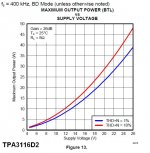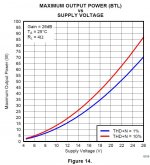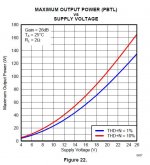Hello,
In real life there is a limit of output power versus power supply, even with technology upgrades (PBTL, new chips...)
With 12V, how much watts (RMS) can I expect today ?
In real life there is a limit of output power versus power supply, even with technology upgrades (PBTL, new chips...)
With 12V, how much watts (RMS) can I expect today ?
How much do you want?
1000W seems pretty common.
Up-converting to 48V or even 80V is not unheard of if needed
Or could use an inverter to get mains AC output?
1000W seems pretty common.
Up-converting to 48V or even 80V is not unheard of if needed
Or could use an inverter to get mains AC output?
Just because the LI pack **can** be charged by the alternator,
does not mean any of the off-grid audio system **must** be tied to the car.
100Ah units are very portable, not heavy like lead.
does not mean any of the off-grid audio system **must** be tied to the car.
100Ah units are very portable, not heavy like lead.
elevating supply with converter, is a trick avalaible for any class amplifier. But without converter, what max power can we expect ?
A TPA3116 will give you about 15-20W (depending on how much THD you accept) from about 13v into 4Ohm. If you want more power you need to find lower impedance drivers, Bose used to do 2Ohm and lower drivers for some OEM car audio for this very purpose. I've also done things like multiple midbass drivers in parallel to drop the impedance.
you pointed to the right argument that drive me to class D : I look for a 100W RMS mono amplifier with low heating and low EMI radiation.
Typical class d power output numbers in BTL (or PBTL) vs supply vs load.
This is without voltage boosters.
So if you want 100W you need aprox 22V single supply and 2R loads.
There are other solutions.
This is without voltage boosters.
So if you want 100W you need aprox 22V single supply and 2R loads.
There are other solutions.
Attachments
Last edited:
thanks for the curves. Is it rms or "musical watts" (peak) ?
You said "There are other solutions." , what is your advice ?
You said "There are other solutions." , what is your advice ?
Let's assume TPA3116 can go pk to pk 12V with car's alternator of 14.4V.
Vrms = 12 / (2 x 1.414) = 4.24V
Speaker 4 ohm will get around 4.5W non clip.
You can actually go down to 3 ohm which will get you 6W.
Vrms = 12 / (2 x 1.414) = 4.24V
Speaker 4 ohm will get around 4.5W non clip.
You can actually go down to 3 ohm which will get you 6W.
TPA3251you pointed to the right argument that drive me to class D : I look for a 100W RMS mono amplifier with low heating and low EMI radiation.
That would be true if the output was single-ended. But it's not - each "half" of the TPA3116/TPA3118 is a pair of already-bridged amps 😉
Let's assume TPA3116 can go pk to pk 12V with car's alternator of 14.4V.
Vrms = 12 / (2 x 1.414) = 4.24V
Speaker 4 ohm will get around 4.5W non clip.
You can actually go down to 3 ohm which will get you 6W.
That would be true if the output was single-ended. But it's not - each "half" of the TPA3116/TPA3118 is a pair of already-bridged amps 😉
Oops. I forgot BTL.
18W for 4 ohm and 24W for 3 ohm.
I was thinking yesterday why did the power goes so low. 😛
Thanks for pointing out.
18W for 4 ohm and 24W for 3 ohm
So module with integrated smps will be mandatory. It will better for noise and RFI isn't it ?
thanks for the curves. Is it rms or "musical watts" (peak) ?
You said "There are other solutions." , what is your advice ?
If you want 100W then you must operate with a higher voltage supply regardless of the output amplifying device...this is what higher power car amplifiers do internally.
There are standalone 12V to ~26V boosters that have been used for ghetto blasters on this forum (somewhere).
But remember your 100W output need about 118W (class D 88% efficient) input power and the booster would need close to 150W (80% efficient) and that needs 12V at ~12.5A...just sayin.
thanks DUG,
You allow my project to make a step ahead. Your evaluation of power efficiency is very helpfull.
I did not found posts about boosters with search tool but it's not the prime problem.
Next step EMI : there are litterature about class d and EMI, but I did found any links about combined amplifier-converter behaviour. Not only from interacts between the two but above all for RFI. My project must not disturb radios links.
You allow my project to make a step ahead. Your evaluation of power efficiency is very helpfull.

I did not found posts about boosters with search tool but it's not the prime problem.
Next step EMI : there are litterature about class d and EMI, but I did found any links about combined amplifier-converter behaviour. Not only from interacts between the two but above all for RFI. My project must not disturb radios links.
- Home
- Amplifiers
- Class D
- class D with car power supply


